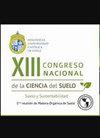NITROGEN SOIL BUDGETS IN CONTRASTING DAIRY GRAZING SYSTEMS OF SOUTHERN CHILE, A SHORT-TERM STUDY
Revista De La Ciencia Del Suelo Y Nutricion Vegetal
Pub Date : 2010-01-01
DOI:10.4067/s0718-27912010000200008
引用次数: 8
Abstract
In recent years, the intensification of livestock production in Southern Chile has resulted in a high potential for environmental damage through nitrogen (N) losses, creating the need for the evaluation of N flows from these systems. The aim of the research was to determine N budgets and N use efficiency in two grazing systems in Southern Chile. For this, inputs and outputs were measured during one year on two grazing systems (heavy grazing, HG; and light grazing, LG). Also, a control treatment with no grazing (C) was considered. The annual N soil budget was determined by the difference between all N inputs (£ inputs) and all N outputs (X outputs). The results of the experiment indicate that HG treatments received the biggest N input (427, 359 and 288 kg N ha-1 yr-1 for HG, LG and C treatment, respectively), however this treatment also had the biggest N losses (406 kg N ha-1 yr-1), with a nitrogen recovery efficiency from fertilizer of 71%. In addition, herbage dry matter yield (DM) was greater in the HG than in the LG and C treatments (10.4; 8.1 and 7.1 t N ha-1 yr-1, respectively). Also, N concentration in the forage was higher in this treatment (2.9%) than in the LG (2.7%) and C (2.5%) treatments. The results indicate that HG increases N use efficiency in pastures in Southern Chile, increasing the herbage production and quality, but also increasing the potential for N losses to the wider environment. Farmers should consider this when choosing the appropriate grazing system.对比智利南部奶牛放牧系统的氮土壤收支,短期研究
近年来,智利南部畜牧业生产的集约化导致氮(N)损失对环境造成巨大破坏的可能性,因此需要对这些系统的氮流量进行评估。研究的目的是确定智利南部两个放牧系统的氮素预算和氮素利用效率。为此,在两种放牧系统(重度放牧,HG;和轻度放牧,LG)。另外,还考虑了不放牧的对照处理(C)。土壤年度氮收支由所有N投入(£投入)和所有N产出(X产出)之间的差额决定。试验结果表明,HG、LG和C处理的N输入量最大(分别为427、359和288 kg N / h -1年-1),但该处理的N损失也最大(406 kg N / h -1年-1),氮素回收效率为71%。此外,HG处理的牧草干物质产量(DM)显著高于LG和C处理(10.4%;分别为8.1和7.1 t N ha-1 year -1)。此外,该处理的牧草氮含量(2.9%)高于LG(2.7%)和C(2.5%)处理。结果表明,HG提高了智利南部牧场氮素利用效率,提高了牧草产量和质量,但也增加了氮素向更广泛环境损失的可能性。农民在选择合适的放牧制度时应考虑到这一点。
本文章由计算机程序翻译,如有差异,请以英文原文为准。
求助全文
约1分钟内获得全文
求助全文

 求助内容:
求助内容: 应助结果提醒方式:
应助结果提醒方式:


